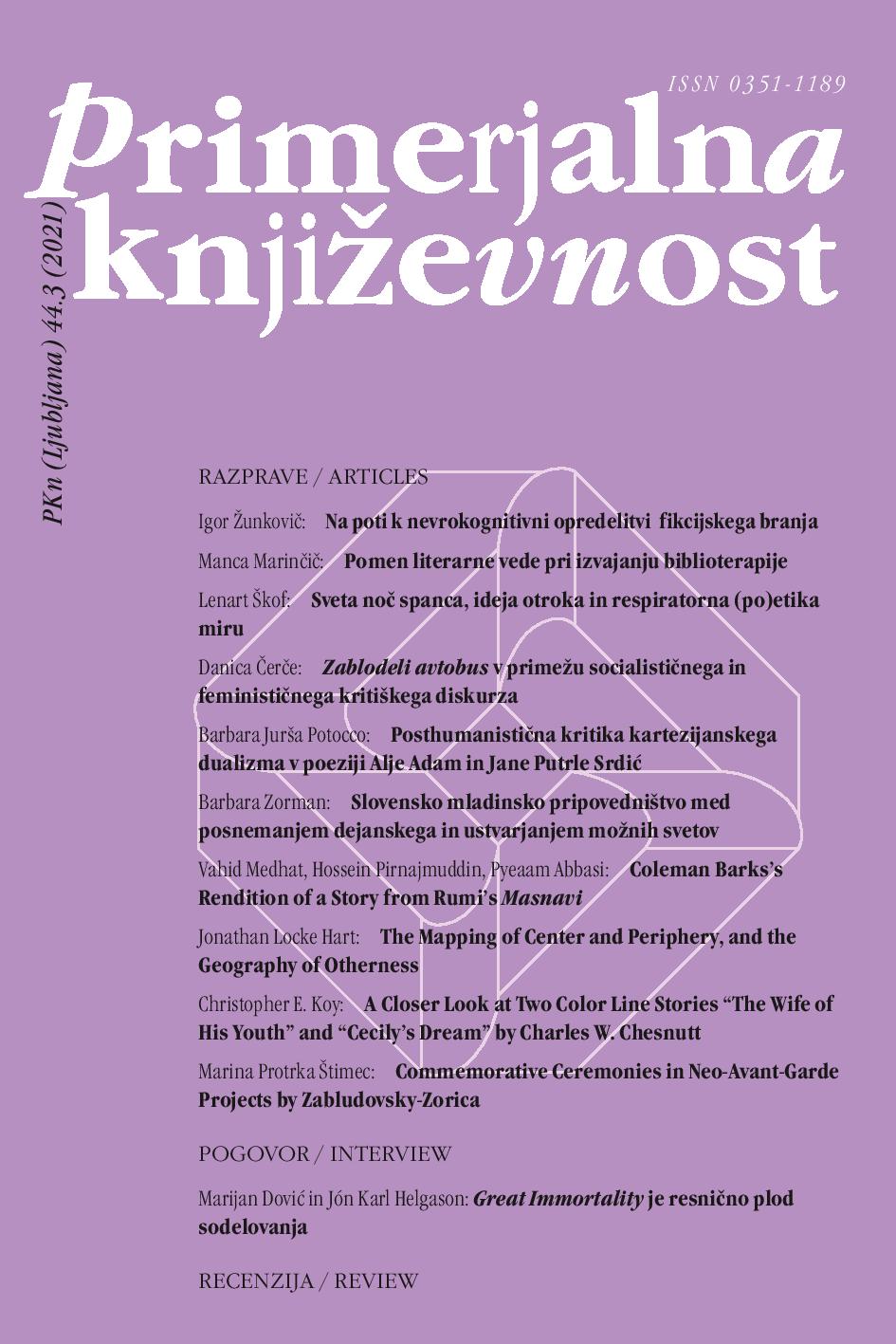Possible Worlds in Translation: Coleman Barks’s Rendition of a Story from Rumi’s Masnavi
DOI:
https://doi.org/10.3986/pkn.v44.i3.07Keywords:
translation studies, Persian poetry, Jalal al-din Rumi: Masnavi, English translation, possible worlds theory, textual universe, narrative world, plot, tellabilityAbstract
This article applies the theory of possible worlds to the field of translation studies by examining the narrative worlds of original and translated texts. Specifically, Marie-Laure Ryan’s characterization of possible worlds provides an account of the internal structure of the textual universe and the progression of the plot. Based on this account, one of the stories from Rumi’s Masnavi is compared to Coleman Barks’s English translation. The possible worlds of the characters and the unfolding of the plots in both texts are examined to assess the degree of compatibility between the textual universes of the original and the translated texts and how significant this might be. It also examines how readers reconstruct the narrative worlds projected by the two texts. The analysis reveals some inconsistencies in the way the textual universes of the original and translated texts are furnished and in the way readers reconstruct the narrative worlds of the two texts. The inability of translation to fully render the main character results in some loss in terms of the pungency and pithiness of the original text. It is also shown that the source text presents a richer domain of the virtual in comparison, suggesting a higher degree of tellability in the textual universe of the Masnavi’s narrative.
References
Chatman, Seymour. <em>Story and Discourse</em>. Ithaca, NY; London: Cornell University Press, 1978.
Doležel, Lubomir. <em>Heterocosmica: Fiction and Possible Worlds</em>. Baltimore, MD: Johns Hopkins University Press, 1998.
Eco, Umberto. <em>The Role of the Reader</em>. Bloomington, IN: Indiana University Press, 1979.
Field, Claud. “The Master Mystic.” <em>Expository Times</em> 17.10 (1906): 452–453.
Fludernik, Monika, and Greta Olson. “Assessing Current Trends in Narratology.” <em>Current Trends in Narratology</em>. Ed. Greta Olson. New York, NY; Berlin: De Gruyter, 2011. 1–35.
Halverson, Sandra L. “Cognitive Translation Studies: Developments in Theory and Method.” <em>Translation and Cognition</em>. Eds. Gregory M. Shreve and Erik Angelone. Amsterdam: John Benjamins, 2010. 349–369.
Kripke, Saul A. “Semantical Considerations on Modal Logic.” <em>Acta Philosophica Fennica</em> 16 (1963): 83–94.
Leibnitz, Gottfried W. <em>Theodicy: Essays on the Goodness of God, the Freedom of Man and the Origin of Evil</em>. Transl. E. M. Huggard. La Salle, IL: Open Court Publishing, 1985.
Lewis, David. “Counterpart Theory and Quantified Modal Logic.” <em>Journal of Philosophy</em> 65.5 (1968): 113–126.
Lewis, Franklin. <em>Rumi: Past and Present, East and West. The Life, Teaching and Poetry of Jalal al-din Rumi</em>. Oxford; New York, NY: Oneworld Publications, 2001.
Lewis, Franklin. <em>Rumi: Swallowing the Sun. Poems Translated from the Persian</em>. Oxford; New York, NY: Oneworld Publications, 2008.
Munoz Martin, Ricardo. “On Paradigms and Cognitive Translatology.” <em>Translation and Cognition</em>. Eds. Gregory M. Shreve and Erik Angelone. Amsterdam: John Benjamins, 2010. 169–187.
Nicholson, Reynold A. <em>The Mathnawi of Jalaluddin Rumi</em>. 3 vol. Cambridge: Cambridge University Press, 1925–1926.
Nünning, Ansgar. “Narratology or Narratologies? Taking Stock of Recent Developments, Critique and Modest Proposals for Future Usages of the Term.” <em>What Is Narratology? Questions and Answers Regarding the Status of a Theory</em>. Eds. Tom Kindt and Hans H. Müller. New York, NY; Berlin: De Gruyter, 2003. 239–276.
Palmer, Alan. <em>Fictional Minds</em>. Lincoln, NE; London: University of Nebraska Press, 2004.
Pavel, Thomas G. <em>Fictional Worlds</em>. Cambridge, MA; London: Harvard University Press, 1986.
Rescher, Nicholas. “The Ontology of the Possible.” <em>Logic and Ontology</em>. Ed. Milton Munitz. New York, NY: New York University Press, 1973. 166–181.
Rimmon-Kennan, Shlomith. <em>Narrative Fiction: Contemporary Poetics</em>. Second edition. London; New York, NY: Routledge, 1989.
Risku, Hanna. “Cognitive Approaches to Translation.” <em>The Encyclopedia of Applied Linguistics</em>. Ed. Carol A. Chapelle. Oxford: Wiley-Blackwell, 2012. 1–10.
Rojo, Ana, and Iraide Ibarretxe-Antunano. “Cognitive Linguistics and Translation Studies: Past, Present, and Future.” <em>Cognitive Linguistics and Translation: Advances in Some Theoretical Models and Applications</em>. Application of Cognitive Linguistics 23. Eds. Ana Rojo and Iraide Ibarretxe-Antunano. New York, NY; Berlin: De Gruyter, Mouton, 2013. 3–30.
Ryan, Marie-Laure. <em>Possible Worlds, Artificial Intelligence and Narrative Theory</em>. Bloomington, IN: Indiana University Press, 1991.
Ryan, Marie-Laure. “Fictional Worlds in Digital Age.” <em>A Companion to Digital Literary Studies</em>. Eds. Ray Siemens and Susan Schreibman. Oxford: Blackwell, 2008. 250–266.
Schimmel, Annemarie. <em>Rumi’s World: The Life and Works of the Greatest Sufi Poet</em>. Boston, MA: Shambhala, 2001.
Semino, Elena. “Possible Worlds and Mental Spaces in Hemingway’s ‘A Very Short Story’.” <em>Cognitive Poetics in Practice</em>. Eds. Joanna Gavins and Gerard Steen. London; New York, NY: Routledge, 2003. 83–98.
Semino, Elena. “Text Worlds.” <em>Cognitive Poetics: Goals, Gains and Gaps</em>. Application of Cognitive Linguistics 10. Eds. Geert Brone and Jeroen Vandale. New York, NY; Berlin: De Gruyter, Mouton, 2009. 34–71.
Shamisa, Siroos. <em>Literary Genres</em>. Tenth edition. Tehran: Ferdos Publication, 2004.
Sharifian, Farzad. <em>Cultural Conceptualisations and Language: Theoretical Framework and Applications</em>. Amsterdam; Philadelphia, PA: John Benjamins Publishing, 2011.
Stockwell, Peter. <em>Cognitive Poetics: An Introduction</em>. London; New York, NY: Routledge, 2001.
Tabakowska, Elżbieta. <em>Cognitive Linguistics and Poetics of Translation</em>. Tübingen: Gunter Narr, 1993.


